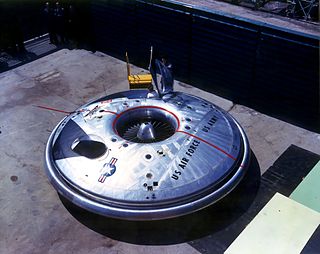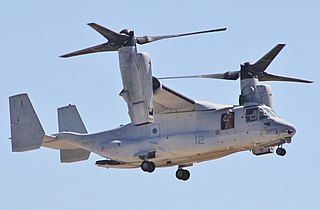Related Research Articles

An aircraft is a vehicle or machine that is able to fly by gaining support from the air. It counters the force of gravity by using either static lift or by using the dynamic lift of an airfoil, or in a few cases the downward thrust from jet engines. Common examples of aircraft include airplanes, helicopters, airships, gliders, paramotors, and hot air balloons.
A vertical take-off and landing (VTOL) aircraft is one that can hover, take off and land vertically without relying on a runway. This classification can include a variety of types of aircraft including helicopters as well as thrust-vectoring fixed-wing aircraft and other hybrid aircraft with powered rotors such as cyclogyros/cyclocopters and gyrodynes.
For fixed-wing aircraft, ground effect is the reduced aerodynamic drag that an aircraft's wings generate when they are close to a fixed surface. Reduced drag when in ground effect during takeoff can cause the aircraft to "float" while below the recommended climb speed. The pilot can then fly just above the runway while the aircraft accelerates in ground effect until a safe climb speed is reached.

Thrust vectoring, also known as thrust vector control (TVC), is the ability of an aircraft, rocket, or other vehicle to manipulate the direction of the thrust from its engine(s) or motor(s) to control the attitude or angular velocity of the vehicle.

The Yakovlev Yak-38 was the Soviet Naval Aviation's only operational VTOL strike fighter aircraft in addition to being its first operational carrier-based fixed-wing aircraft. It was developed specifically for, and served almost exclusively on, the Kiev-class aircraft carriers.

The Yakovlev Yak-141, also known as the Yak-41, is a Soviet supersonic vertical takeoff/landing (VTOL) fighter aircraft designed by Yakovlev. It was used for testing.

The Sud-Ouest Aviation (SNCASO) S.O. 4050 Vautour II was a French jet-powered bomber, interceptor, and attack aircraft developed and manufactured by aircraft company Sud Aviation.

The Yakovlev Yak-24 is a Soviet twin-engine, tandem rotor, transport helicopter developed by Yakovlev in the 1950s. The Yak-24 saw limited use in the Soviet Air Force, and the exact number produced and duration of service are unknown due to inconsistencies in data.

The Avro Canada VZ-9 Avrocar was a VTOL aircraft developed by Avro Canada as part of a secret U.S. military project carried out in the early years of the Cold War. The Avrocar intended to exploit the Coandă effect to provide lift and thrust from a single "turborotor" blowing exhaust out of the rim of the disk-shaped aircraft. In the air, it would have resembled a flying saucer.

A rotorcraft or rotary-wing aircraft is a heavier-than-air aircraft with rotary wings or rotor blades, which generate lift by rotating around a vertical mast. Several rotor blades mounted on a single mast are referred to as a rotor. The International Civil Aviation Organization (ICAO) defines a rotorcraft as "supported in flight by the reactions of the air on one or more rotors".

The Short SC.1 was the first British fixed-wing vertical take-off and landing (VTOL) jet aircraft. It was developed by Short Brothers. It was powered by an arrangement of five Rolls-Royce RB.108 turbojets, four of which were used for vertical flight and one for conventional horizontal flight. The SC.1 had the distinction of being the first British fixed-wing VTOL aircraft and the first one to transition between vertical and horizontal flight modes; it was also the first VTOL-capable aircraft with a fly-by-wire control system.

A powered lift aircraft takes off and lands vertically under engine power but uses a fixed wing for horizontal flight. Like helicopters, these aircraft do not need a long runway to take off and land, but they have a speed and performance similar to standard fixed-wing aircraft in combat or other situations.

The Yakovlev EG, also commonly known as the Yak-M11FR-1 and Sh (Shootka), was an experimental aircraft with coaxial rotors. The prototype was first flown by V.V. Tezavrovsky in December 1947.

The Yakovlev Yak-43 was a Soviet VTOL fighter designed as the ground-based version of the ill-fated Yakovlev Yak-141, which failed to reach production. Like the Yak-141, the Yak-43 did not reach production. The Yak-43 would have been the third-generation VTOL/STOL fighter, to follow and eventually replace the Yak-141.
Yakovlev Yak-45 was the designation for a series of design studies in 1973-1974 for a single-seat fighter. It lost to the Mikoyan MiG-29.
The period between 1945 and 1979 is sometimes called the post-war era or the period of the post-war political consensus. During this period, aviation was dominated by the arrival of the jet age. In civil aviation the jet engine allowed a huge expansion of commercial air travel, while in military aviation it led to the widespread introduction of supersonic aircraft.
References
- Gunston, Bill. Yakovlev Aircraft since 1924. London, UK: Putnam Aeronautical Books, 1997. ISBN 1-55750-978-6.